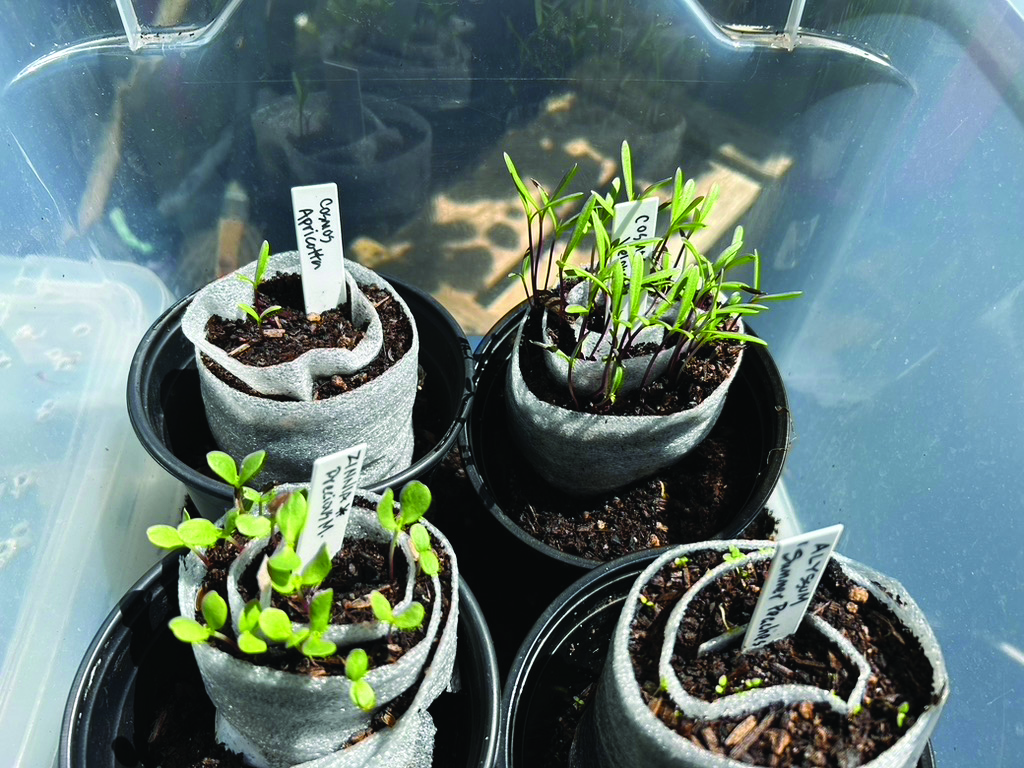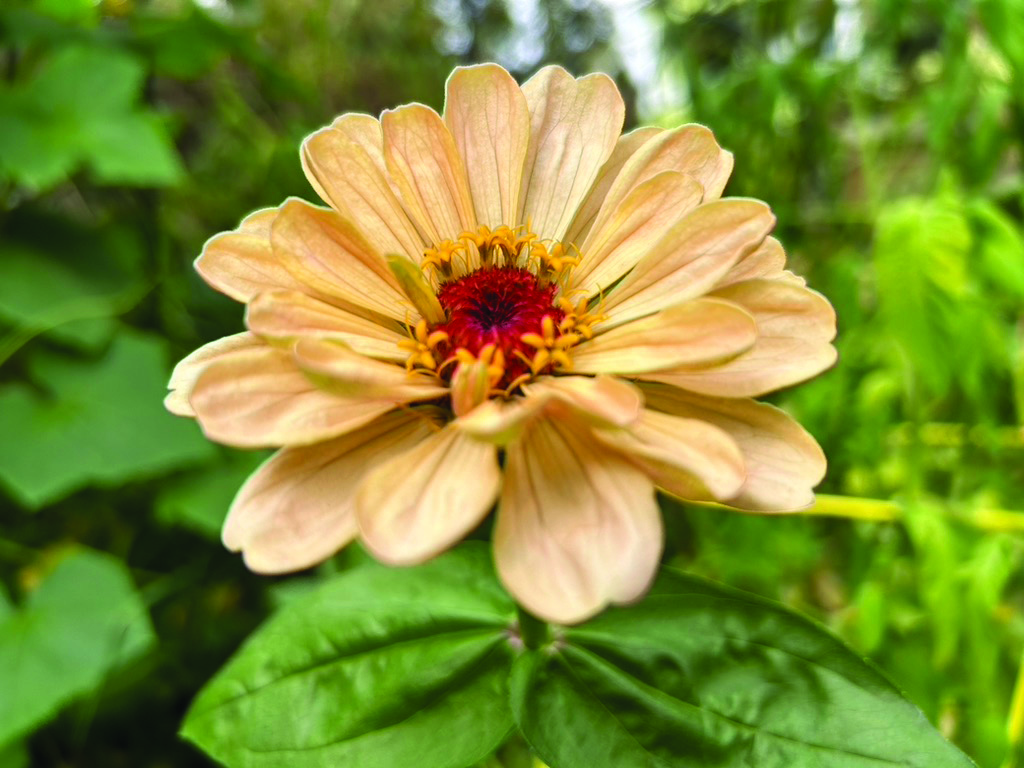With so many trends surfing by on our social media feeds these days, it’s difficult to tell what’s worth our attention. Last year, a particular new garden method caught my eye — and by the look of TikTok, I wasn’t alone.
Innovation is always exciting, especially when it works. This new seed-sowing method, with the funny name of seed snails, was invented and introduced on social media by a UK gardener named Farida Sober (@faridasober on Instagram). In many ways, it’s easier and more efficient than both indoor seed-starting and direct sowing.
Seed snail-sowing (say that five times fast) looks as funny as it sounds, too. When I saw my first video, my jaw dropped. Sober cuts strips of polyethylene sheeting approximately 17” wide by 6” deep, lays them flat, tops them with potting soil (not seed starting mix), leaving some space on the sides and bottom, turns them upright and tapes the sides shut. Looking at the “snail” from the top, it looks like a cinnamon roll – that’s what I wish it was named – but so be it. She sows the seeds rather thickly in the soil on the top of the cinnamon roll, choosing the appropriate depth for that type of seed. She stacks them upright in potting trays or cookie sheets, but you can also hold them in round plastic pots or collected in plastic storage tubs (more on that later).
Sober is growing in a greenhouse, but you can use this method indoors with grow lights or outside under proper weather conditions for the seeds you’re growing.
Let’s compare this with traditional sowing in trays. It requires a lot of stuff, time, and space. Typically, you’d sow 2-5 seeds in a cell, with each tray taking up 10” x 20”. Using special seed starting mix is recommended, so that’s an extra purchase. When the seedlings outgrow their 2” deep cell, you need to transplant them to individual pots, taking up even more space, pots, and soil. They require monitoring every other day to prevent drying out.
 Using a tub to keep the snail upright and away from critters was helpful. Courtesy Erica Browne Grivas
Using a tub to keep the snail upright and away from critters was helpful. Courtesy Erica Browne GrivasAnother benefit to the snails is they hold moisture longer than tiny cells, encourage long roots and may discourage root circling. In Sober’s method, if the seeds need more space, and you’re not ready to transplant yet, you open the seed snail and add more soil, making a fatter roll (that’s why you leave some inches on the side). You can’t keep seedlings in the snail roll indefinitely; she states that at some point transplanting into individual pots if needed yields bigger plants.
If you’re growing indoors, I imagine the plants would stay better watered with extra soil and insulation, but you’d still have the potential issues of managing lighting, avoiding dampening off fungus, and hardening off to outside temperatures.
Outdoor growing is where it was a real eyeopener for me. My best successes with outdoor seed growing have all been accidental. Seeds often find their own favorite spot, despite your plans. A viola seeded into a crack in my driveway, and Cerinthe major routinely grows into my steps instead of my garden bed. Nigella just goes wherever the heck it wants.
My other direct sowing attempts are, well, haphazard. Even sticking with “easy to grow” seeds like peas, calendula, runner beans, and zinnias, my results have been iffy. Seedlings and their feeder roots are so delicate in the early stages that drying out even once can do them in. It’s best if you have a dedicated open area with friable soil that is consistently watered. My theory is that I forget to water them and leave them unprotected from birds, critters and my own boots.
Enter seed snails. I tried one round of growing outdoors mid-June last year and I was very happy with the results. I sowed cosmos and zinnias into polyethylene wrap I had in my mailing supplies.
An important note: Limiting plastic in our gardens and waterways is important, so some environmentally friendly options to wrap your snails with include corrugated cardboard, “duck” cotton canvas, coconut coir matting, row cover, and newspaper. It should be somewhat permeable, but moisture- retentive.
I had clear plastic tubs I drilled with drainage holes for winter sowing, so I popped the rolls into plastic pots (4 inch or one quart), and stacked them into the open tubs. In cool weather, I’d use the lids on which are also drilled to allow rain and water in, but seedlings would roast in midsummer.
 The author sowed Zinnia 'Floret Precious Metals' in a seed snail June with great results. Courtesy Erica Browne Grivas
The author sowed Zinnia 'Floret Precious Metals' in a seed snail June with great results. Courtesy Erica Browne GrivasBy keeping them in the snails in partial shade, they retained moisture better and weathered the weather. Because they were right by my kitchen door, I remembered to water them. Corralled in tubs, they were less likely to be stomped by me or eaten by birds or cutworms.
In three weeks, they were ready for transplanting, and by September I had lovely blooms of Cosmos ‘Velouette’ and Floret Zinnia ‘Precious Metals,’ which offered me scads of late-season bouquets. The cosmos did well in a pot, but the zinnias fully thrived in a large, raised bed. The hardest part was planting and keeping the transplants watered in the heat of July, so I’ll start earlier next year.
Seed snails are helping me win at sowing. Do I wish I had the time and open garden real estate to nurture rows of fantastic flower seedlings? You bet. But that’s a fantasy on my cramscaped city plot. This way I get the seedlings through their most vulnerable stage with little effort and can transplant these stronger plants into existing borders more easily.
My next experiment is to try combining the space-saving efficiency of seed snails with winter sowing.
Want to learn more about easy seed-sowing techniques?
I’ll be speaking at the Northwest Flower and Garden Festival (gardenshow.com, Feb. 19-23 at the Seattle Convention Center) on The Easiest Seed-Starting: Winter Sowing and Seed Snails on Friday, Feb. 21 at 10 a.m. on the DIY stage. You ticket to the show includes lectures, access to amazing display gardens, and a bustling market of home, garden and vintage wares.